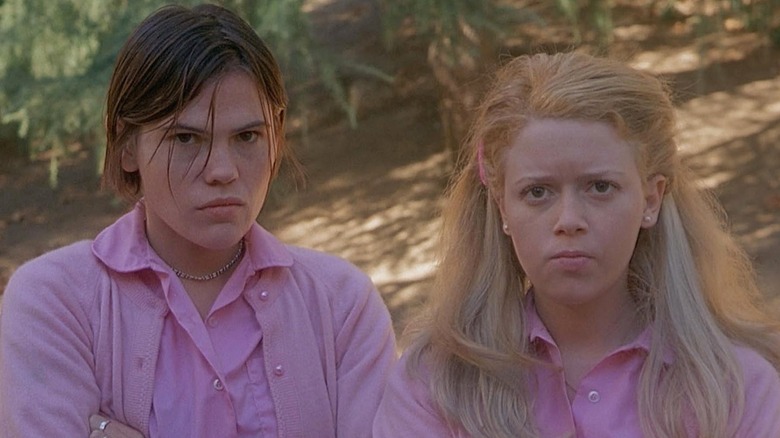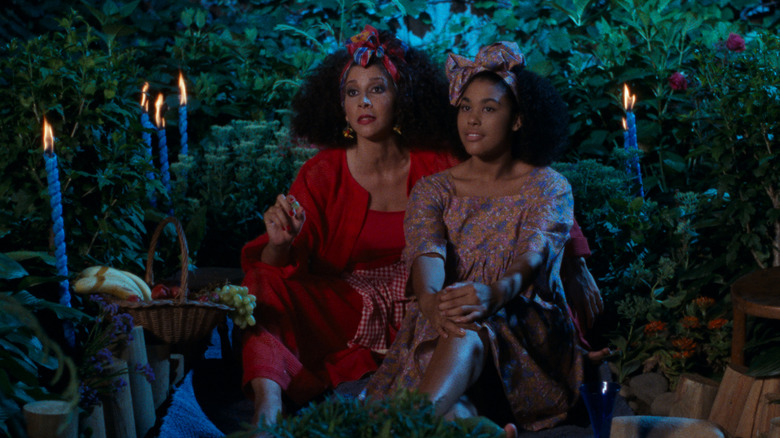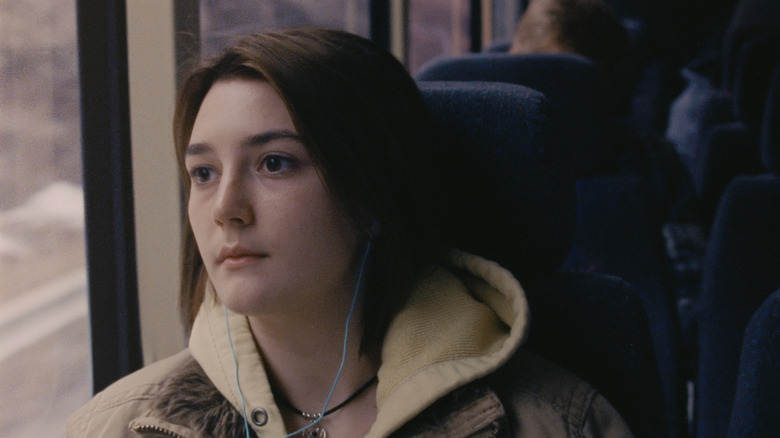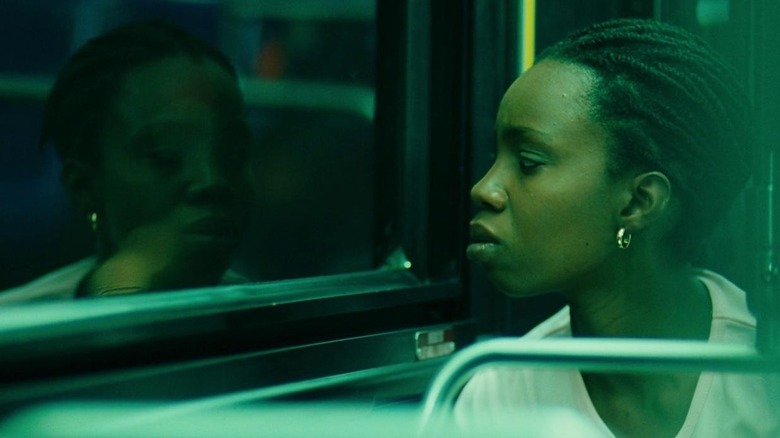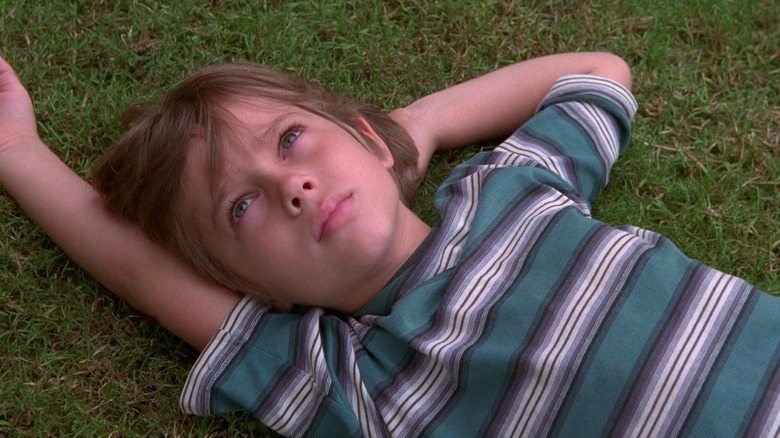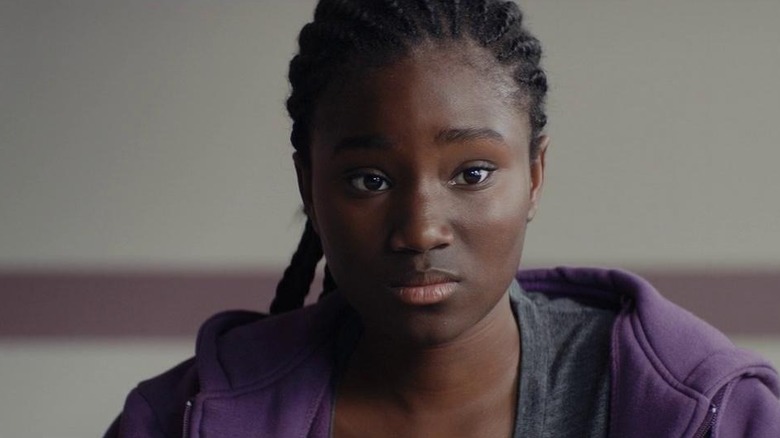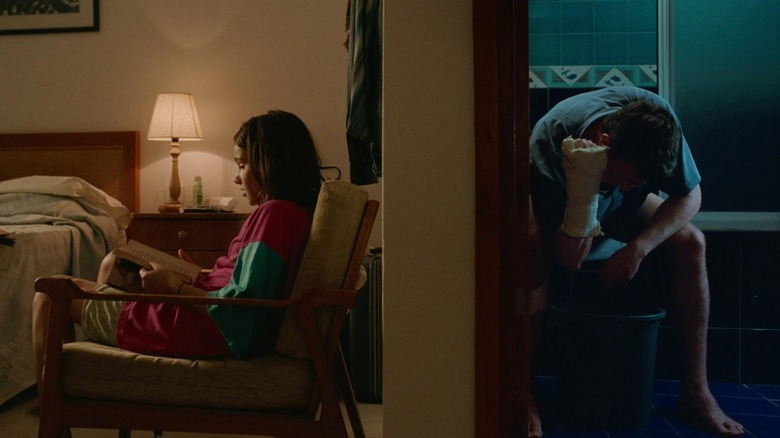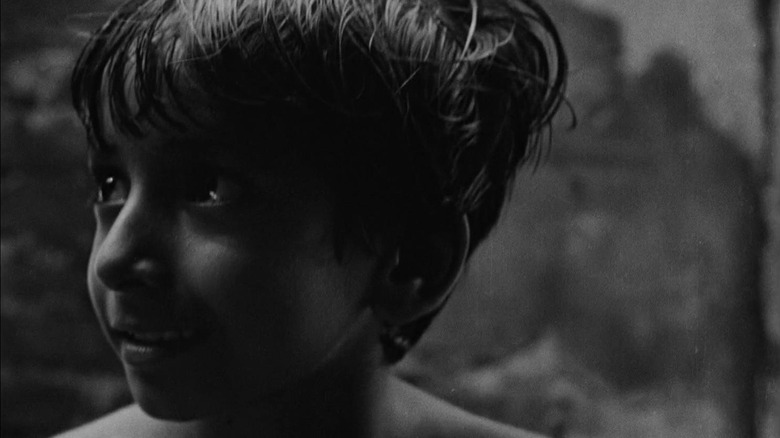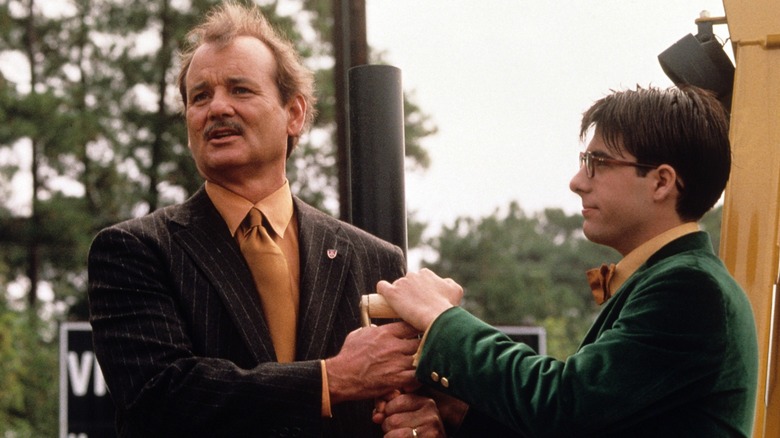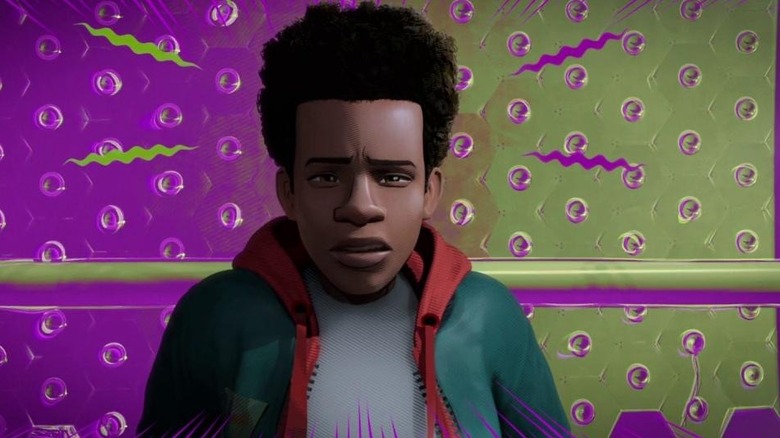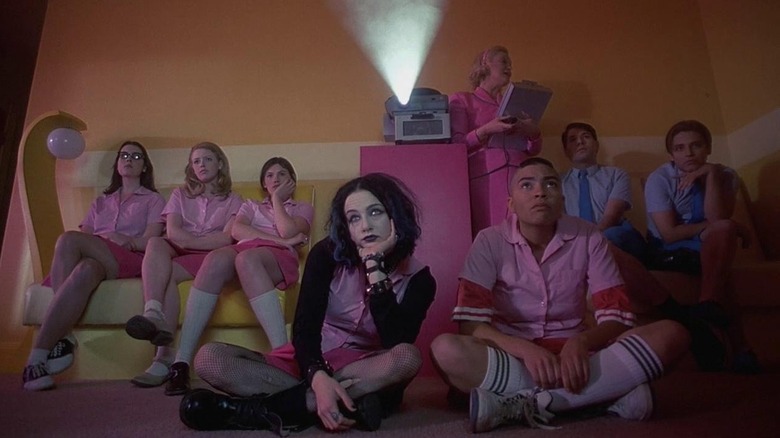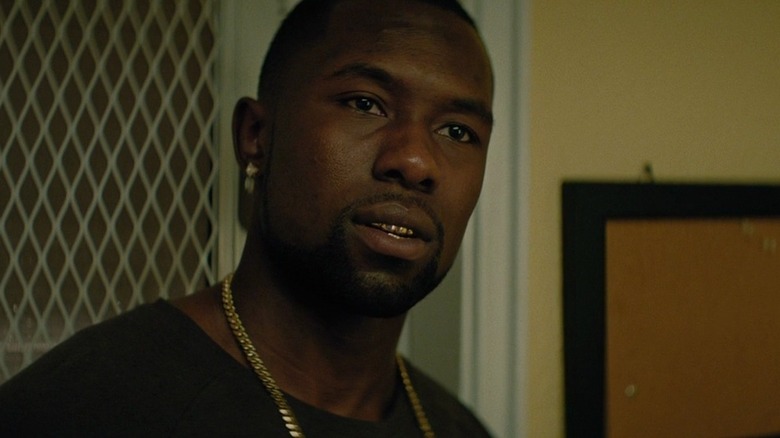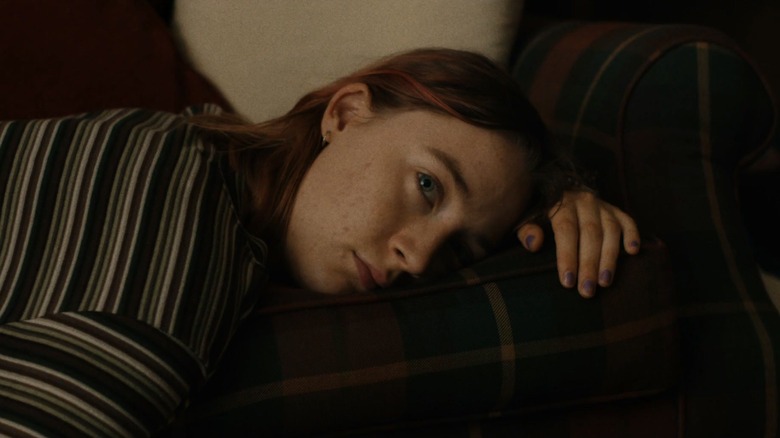12 Best Coming-Of-Age Movies Ranked
Growing up is turbulent, and nobody goes through the process emotionally unscathed. It's not even something just limited to your pre-college years, since some of the most profound growth that people can experience comes before we turn 18 years old. That's the time of life that coming-of-age movies fixate on. These films are often about characters of various ages (from teenagers to very young adolescents) navigating the larger world and discovering new parts of both themselves and the realities they live in.
This is such a messy undertaking, but also one that movies can help make a little more bearable. After all, the best coming-of-age films make audiences feel a little less alone, since the lives of the characters on-screen are just as messy as the audience's.
The following 12 coming-of-age movies are especially outstanding triumphs of craftsmanship, as well as reminders of how potently cinema can render formative life experiences. Some of these films earn their stature through tremendous visual ingenuity. Others are impeccable showcases for unforgettable performances. There is no shortage of exemplary ways for movies to realize coming-of-age narratives, and ranking these 12 movies (from "least best" to best) just makes one appreciate how much of a gift this genre of cinema is.
12. Alma's Rainbow
When we recall memories of yesteryear, rarely do these visions appear in monochromatic or muted hues. Instead, they flourish in our brains with extra vibrant colors, particularly whenever there's hopeful or happy emotions attached to them. Elements of 1994's excellent "Alma's Rainbow," such as the costume designs from Sidney Kai Innis, vividly create a cinematic experience as visually sumptuous as it is emotionally engaging.
Writer-director Ayoka Chenzira's sole feature-length filmmaking credit chronicles the journey of Rainbow Gold (Victoria Gabrielle Platt), whose life in Brooklyn gets turned upside down when her long-absent aunt Ruby (Mizan Kirby) bursts back onto the scene. Very quickly, a lady who's been M.I.A. from Rainbow's existence for years begins influencing and changing this girl's life in drastic ways.
We can never predict which people in our lives will forever shape us. That's one of many compelling aspects of life that Chenzira tenderly realizes with her absorbing direction in "Alma's Rainbow." The acting here is extraordinary (Platt especially handles weighty material with such naturalism), while the nuance and rich details afforded to key dynamics — like Rainbow's rapport with her mother Alma (Kim Weston-Moran) — make this 85-minute gem feel incredibly lived-in. So deeply specific to the world of its characters yet universally captivating in its craft, "Alma's Rainbow" is a masterclass movie that deserves infinitely more praise and prominence.
11. Never Rarely Sometimes Always
Some people get to grow up with plenty of external support, but "Never Rarely Sometimes Always" protagonist Autumn Callahan (Sidney Flanigan) begins the film by enduring hardships very much alone, even in a crowded high school auditorium where everyone laughs at her while she's singing in a talent show.
Her sense of isolation only heightens once she realizes she's pregnant and needs to get an abortion, a plan that will require her to travel to New York City. Her cousin Skylar (Talia Ryder) is her only companion as she navigates the Big Apple. This is a formative journey for Autumn, carried out in quiet corners and back alleyways with sneakily procured money and underscored by cruel stigmas against women's bodily autonomy.
Writer-director Eliza Hittman delivers extraordinary work, rendering all this coming-of-age turmoil in exceedingly impactful yet subdued terms. Even just a close-up shot of Autumn and Skylar's hands interlocking in a pivotal moment of distress is enough to send even the most jaded viewers into tears despite the sparse soundtrack and subdued color scheme. Impeccably realized cinematography and two stupendous lead performances further accentuate the evocative, chilly atmosphere. A haunting portrait of hushed teenage girl turmoil even in the most crowded spaces, "Never Rarely Sometimes Always" is downright unforgettable.
10. Pariah
It takes some directors two or more films to really excel at their craft, but not filmmaker Dee Rees. This extraordinary artist hit the ground running as an auteur with her outstanding debut title, "Pariah." This 2011 feature explores the life of socially distant 17-year-old Alike (Adepero Oduye), a lesbian firmly living in the closet whose inability to embrace her true self had led to her withdrawing from the rest of the world.
That all changes when she's forced to hang out with Bina (Aasha Davis), another girl her age who slowly gets Alike to come out of her shell. The ensuing story is all about Alike and best friend Laura (Pernell Walker) navigating and discovering the hardships of life: Romantic connections that can never materialize. Familial bonds that will never be tight-knit. Coming-out experiences thrust upon queer folks.
These bitter aspects of existence never get easier to navigate, but they're especially harrowing when they're experienced for the first time as a teenager. Rees achingly captures these struggles in "Pariah" while also fleshing out the interiority of Alike and Laura so that they're not just defined by their anguish. These two are such transfixing characters, which is why "Pariah" is such a compelling movie. Bradford Young's exquisite cinematography, rife with richly empathetic imagery, only sweetens this cinematic concoction. Dee Rees truly knocked her directorial debut out of the park with this remarkable coming-of-age yarn.
9. Boyhood
Richard Linklater's fascination with the passage of time reached its zenith (at least until that "Merrily We Roll Along" movie drops) with 2014's "Boyhood," which chronicles the life of a boy named Mason (Ellar Coltrane) over the course of 12 years. Shot in real time, Linklater's trademark quiet style of filmmaking allows "Boyhood" to intimately explore all the small moments that make Mason who he is over a dozen years in his life.
Many other coming-of-age films reduce the process of growing up to fleeting montages. "Boyhood," meanwhile, lets the camera linger on the tiniest experiences, like smashing planks of wood in an unfinished house or watching a stepfather's terrifying outburst that forever leaves a mark on Mason's psyche. Viewers witness the psychological puzzle pieces slowly come together to form the picture that is Mason as he heads off to college.
Watching this gradually assembled movie execute that glacial character arc is a mesmerizing feat. Time's ceaseless march has rarely been as vividly realized as it is in "Boyhood." That quality is especially potent in the hands of supporting performers Ethan Hawke and Patricia Arquette as Mason's birth parents. The latter actor has an unforgettable existential scene in which she realizes that Mason becoming an adult so quickly means her life will inevitably vanish in the blink of an eye. It's the kind of haunting yet naturalistic reflection on mortality that could only exist through the distinct filmmaking style of Richard Linklater.
8. Girlhood
Sometimes, all it takes is one sequence to render a movie a masterpiece. It's not the rest of the film is subpar, but rather this one particular segment is so exemplary that nothing else can touch it. So it is with Celine Sciamma's 2014 directorial effort "Girlhood," which features a sequence in which Marieme (Karidja Toure) solidifies her newfound friendship with fellow teenage girls Lady (Assa Sylla), Fily (Marietou Toure) and Adiatou (Lindsay Karamoh) by dancing to Rihanna's "Diamonds" with them.
Told largely in one unblinking shot, this momentous scene is deeply moving just through Toure's quiet physical acting, as she portrays Marieme going from feeling shy to exuberantly dancing with her pals. The fact that the lyrics of "Diamonds" feel so especially resonant to this moment of growth (not to mention that it's a tune that would be relevant and important to teenagers circa 2014) is just the cherry on top, as Marieme embraces the kind of profound human connections she's yearned for in her life.
The rest of "Girlhood" is still excellent, as one would expect from "Portrait of a Lady on Fire" director Celine Sciamma. While her writing painfully portrays the quiet misogynistic adversity teen girls like Marieme tragically endure, the evocative personalities of Marieme and her companions are similarly absorbing.
7. Aftersun
A core part of growing up is realizing your parents are people. The folks you turn to for all the answers when you're young are also flawed, messy human beings making things up as they go along. Not a lot of coming-of-age movies dare confront such harrowing material, but the Charlotte Wells-directed triumph "Aftersun" does so spectacularly.
The film follows Sophie (Frankie Corio) and her dad Calum ("Gladiator 2" star Paul Mescal) as they head to a Turkish resort for a holiday. Sophie is keen to record parts of the vacation with her camcorder, though this device can't hope to capture the internalized anguish her dad is going through. Calum loves his daughter, but he's also navigating demons like depression and other psychological disorders. He's also prone to waking up on the beach in a drunken daze rather than in the duo's hotel room.
Throughout "Aftersun," Sophie constantly tries to get close to her father. This manifests in literal scenes of the duo on vacation in 1999, dreamlike digressions to a rave, or flash-forwards to adult Sophie quietly revisiting footage of this trip. Through it all, one constantly sees a daughter grappling to connect to a father that's loving but also just out of reach. That's a devastating part of growing up — realizing that you'll never fully understand someone you love and cherish. The raw pathos and inspired imagery of "Aftersun" (the latter especially apparent in a closing scene set to "Under Pressure") provide a stirring testament to this painful reality of growing up.
6. Pather Panchali
Apu Roy (Subir Banerjee) grows up in very ordinary, run-of-the-mill conditions with his parents and older sister Durga (Uma Dasgupta). His existence is the crux of "Panther Panchali" and the focus of director Satyajit Ray's observational style of filmmaking. At times, "Panchali" feels like the result of someone leaving a camera rolling in a typical household. The performances, staging, and other elements exude naturalism rather than being ornately composed for outside viewers. That makes this chronicling of Apu growing up so extra compelling emotionally. There's an inescapable sense of reality to this child's circumstances and discovery of life's harsher elements. Only through Ray's assured, immersive directing style could that level of engagement be possible.
Like the best coming-of-age films, "Pather Panchali" unearths significant meaning in aspects of everyday life that viewers may take for granted. Much like "The Florida Project" excavated monumental pathos in a fallen tree, so too does "Pather Panchali" explore how things like a passing train could immensely affect Apu's psychology. Ray's unhurried filmmaking approach lets those moments of mundane joy wash over viewers. In the years that followed the 1955 release of "Pather Panchali," other features like "The 400 Blows" would follow in its footsteps by delivering grounded, complex explorations of adolescent existence. Decades later, "Pather Panchali" still resonates as incredibly idiosyncratic in the coming-of-age cinematic canon.
5. Rushmore
For just his second film, writer-director Wes Anderson hit a creative home run with "Rushmore." The story of Max Fischer (Jason Schwartzman) concerns a teenager who, in many ways, could only exist in an Anderson movie. Just look at his artistic pursuits and intellectual interests. However, like with all Anderson features, a discernibly authentic reality lurks beneath a stylized exterior. Max's experiences in "Rushmore" echo any know-it-all teenager's gradual realization that they actually don't have the world figured out. Not even this kid enrolled in so many extracurricular activities can comprehend or control everything around him.
"Rushmore" focuses on that point in our teenage existences when we realize how messy and nuanced the wider world is. Meanwhile, Schwartzman's tremendous performance makes Max a sensational lead character even at his most insufferable. Schwartzman has a undercurrent of youthful vulnerability that wisely emphasizes Max's inexperience, which dilutes some of his potential aggressiveness.
Anderson's precise visual impulses and needle drop proclivities, meanwhile, have rarely been more refined. Who better to complement melancholy teenage growth than the vocals of Cat Stevens? On top of all that, "Rushmore" is just incredibly funny, with practically every scene delivering an all-time great bit of dialogue, while the film's depiction of high school displays impressive craftsmanship and sizable heart. With this coming-of-age masterwork, Wes Anderson had truly arrived.
4. Spider-Man: Into the Spider-Verse
What's remarkable about animation is that it's a medium where truly anything is possible. Your imagination can produce stunning, stylized images that would be impossible in the realm of live action. Those gifts make it a perfect place to render coming-of-age struggles, as "Spider-Man: Into the Spider-Verse" masterfully portrayed. This movie's heightened touches, like rapid-fire editing, text boxes, and dynamic camerawork, lend vivid life to the struggles of Miles Morales (Shameik Moore) as he deals with everything from high school social struggles to devious super-villains. The innate theatricality of the movie's visual scheme embodies Miles' evolution in striking terms that few live-action films could hope to accomplish.
Few coming-of-age movies have produced a sequence as satisfying as the big "What's Up, Danger?" set piece, in which Miles finally comes into his own as both Spider-Man and a human being. It's an awe-inspiring work of editing, animation, music, and storytelling, an extraordinary scene in which Miles' growth is exquisitely tangible. To complement its glories as a visually-oriented character study, "Into the Spider-Verse" is an absolute riot as entertainment. Countless visual and verbal gags are crammed into every inch of the runtime, including the opening studio logos. That's what happens when imagination is fueled by the limitless possibilities of animation.
3. But I'm a Cheerleader
The greatest movies are often a paradox. They deftly combine elements that should never work together into something exciting, new, and audacious. So it is with Jamie Babbit's masterpiece "But I'm a Cheerleader," which merges bubbly Douglas Sirk-inspired production design with the story of Megan Bloomfield (Natasha Lyonne) and other queer teenagers navigating a conversion camp.
These horrific locations are, in the real world, places of immense trauma. "Cheerleader" renders these places in ludicrous fashion, full of brightly-colored walls, outfits with inexplicably queer sensibilities, and deliciously arch counselors. Rather than minimizing the horrors of these facilities, Babbit and company ingeniously smack a clown nose on institutions like this that demand to be taken seriously. "Fixing" someone's queerness is a ludicrous proposition, so these places should appear on-screen in a similarly preposterous manner.
Amidst these hyperbolic visuals, "But I'm a Cheerleader" also weaves a tender yarn about Megan coming to realize her sexuality and falling for more experienced lesbian Graham Eaton (Clea DuVall). Their burgeoning romance is irrepressibly cute, especially thanks to the warm rapport between Lyonne and DuVall. The best coming-of-age movies often make every facet of a young character's growth hit the audience like an oncoming freight train. Babbit certainly accomplishes that here, with each instance of Bloomfield further embracing her queerness downright cheer-worthy. That's the kind of achievement only a confidently paradoxical movie like "But I'm a Cheerleader" could accomplish.
2. Moonlight
One of Barry Jenkins' many fantastic qualities as a filmmaker is the rich empathy emanating off his images. Those famous close-up shots of his, where characters stare directly into the lens, especially radiate the infectious passion that Jenkins has for his on-screen subjects. That quality was put to excellent use in "Moonlight," a feature chronicling the life of young Chiron at three points of his life.
Following this queer character from adolescence (where he's played by Alex R. Hibbert) to teenage years (Ashton Sanders) to adulthood (Trevante Rhodes) is a remarkable experience. Jenkins is unflinching in capturing how societal expectations for masculinity (particularly for Black masculinity) shape who Chiron is right from the start when he asks Juan (Mahershala Ali) what a gay slur means. His camera is similarly unblinking in capturing the beautiful moments of joy that shape Chiron's life, like time spent in the water with Juan or a romantically intimate beachside rendezvous as a teenager with Kevin (Jharrel Jerome).
Having a different actor play Chiron in each segment shows how varied we all are from one point in life to the next. Yet there are subtle consistencies in each actor's take on Chiron that also suggest how the scared child from the opening scene in "Moonlight" is still in there. Jenkins and cinematographer James Laxton deliver rich imagery perfectly complementing these weighty storytelling and acting flourishes — including those close-up shots, which crystallize the empathy and rich humanity coming-of-age cinema is known for.
1. Lady Bird
Few on-screen worlds are as richly developed as Greta Gerwig's vision of Sacramento in 2017's "Lady Bird." Every inhabitant of this place, from convenience store clerks to briefly-seen gym teachers to random New York City denizens, seems to have their own story and life that could fuel a separate movie. Even with this quality, Gerwig's script never loses sight of Christine "Lady Bird" McPherson (Saoirse Ronan).
This high school senior's experiences from fall 2002 to spring 2003 provide an embarrassment of thoughtful cinematic riches. Lady Bird's relationship with her mother, Marion (Laurie Metcalf), is a messy, imperfect bond ripped straight out of life, perfectly realized through the two women's performances. Rarely has such a complex dynamic (and how it molds a teenager's personality) been realized with such poignancy and depth on-screen.
"Lady Bird" is one of those brilliant films where you just want to rattle off its greatest scenes: Lady Bird and Danny's (Lucas Hedges) tearful talk in that alleyway. Lady Bird's prom night. Lady Bird's inaugural chat with aloof conspiracy theorist Kyle Scheible (Timothee Chalamet). All of these and more are specifically part of Lady Bird's world, yet also contain kernels of universally relatable material. If you've never experienced these exact forms of teenage turmoil, "Lady Bird" and its plethora of engaging characters make you feel like you have. Effortlessly accomplishing that is how a movie reaches the pinnacle of coming-of-age filmmaking.
